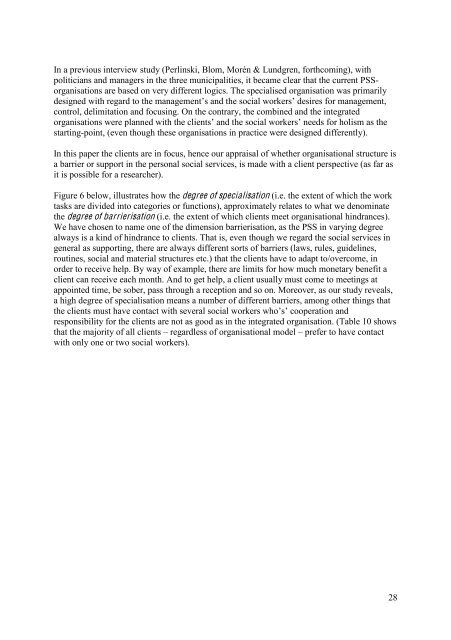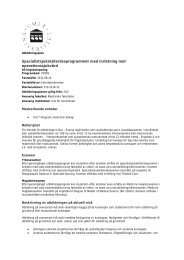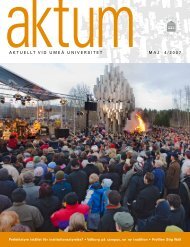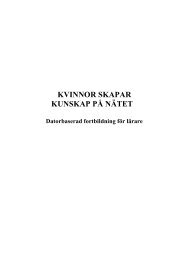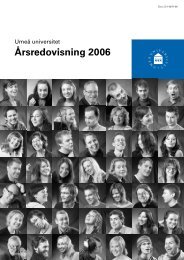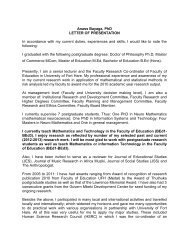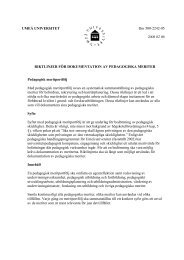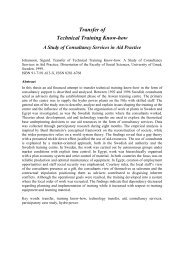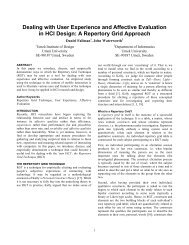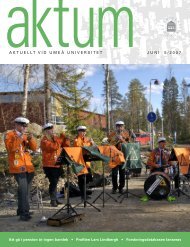Organisational Structure as Barrier or Support in the Personal Social ...
Organisational Structure as Barrier or Support in the Personal Social ...
Organisational Structure as Barrier or Support in the Personal Social ...
You also want an ePaper? Increase the reach of your titles
YUMPU automatically turns print PDFs into web optimized ePapers that Google loves.
In a previous <strong>in</strong>terview study (Perl<strong>in</strong>ski, Blom, M<strong>or</strong>én & Lundgren, f<strong>or</strong>thcom<strong>in</strong>g), withpoliticians and managers <strong>in</strong> <strong>the</strong> three municipalities, it became clear that <strong>the</strong> current PSS<strong>or</strong>ganisationsare b<strong>as</strong>ed on very different logics. The specialised <strong>or</strong>ganisation w<strong>as</strong> primarilydesigned with regard to <strong>the</strong> management’s and <strong>the</strong> social w<strong>or</strong>kers’ desires f<strong>or</strong> management,control, delimitation and focus<strong>in</strong>g. On <strong>the</strong> contrary, <strong>the</strong> comb<strong>in</strong>ed and <strong>the</strong> <strong>in</strong>tegrated<strong>or</strong>ganisations were planned with <strong>the</strong> clients’ and <strong>the</strong> social w<strong>or</strong>kers’ needs f<strong>or</strong> holism <strong>as</strong> <strong>the</strong>start<strong>in</strong>g-po<strong>in</strong>t, (even though <strong>the</strong>se <strong>or</strong>ganisations <strong>in</strong> practice were designed differently).In this paper <strong>the</strong> clients are <strong>in</strong> focus, hence our appraisal of whe<strong>the</strong>r <strong>or</strong>ganisational structure isa barrier <strong>or</strong> supp<strong>or</strong>t <strong>in</strong> <strong>the</strong> personal social services, is made with a client perspective (<strong>as</strong> far <strong>as</strong>it is possible f<strong>or</strong> a researcher).Figure 6 below, illustrates how <strong>the</strong> degree of specialisation (i.e. <strong>the</strong> extent of which <strong>the</strong> w<strong>or</strong>kt<strong>as</strong>ks are divided <strong>in</strong>to categ<strong>or</strong>ies <strong>or</strong> functions), approximately relates to what we denom<strong>in</strong>ate<strong>the</strong> degree of barrierisation (i.e. <strong>the</strong> extent of which clients meet <strong>or</strong>ganisational h<strong>in</strong>drances).We have chosen to name one of <strong>the</strong> dimension barrierisation, <strong>as</strong> <strong>the</strong> PSS <strong>in</strong> vary<strong>in</strong>g degreealways is a k<strong>in</strong>d of h<strong>in</strong>drance to clients. That is, even though we regard <strong>the</strong> social services <strong>in</strong>general <strong>as</strong> supp<strong>or</strong>t<strong>in</strong>g, <strong>the</strong>re are always different s<strong>or</strong>ts of barriers (laws, rules, guidel<strong>in</strong>es,rout<strong>in</strong>es, social and material structures etc.) that <strong>the</strong> clients have to adapt to/overcome, <strong>in</strong><strong>or</strong>der to receive help. By way of example, <strong>the</strong>re are limits f<strong>or</strong> how much monetary benefit aclient can receive each month. And to get help, a client usually must come to meet<strong>in</strong>gs atappo<strong>in</strong>ted time, be sober, p<strong>as</strong>s through a reception and so on. M<strong>or</strong>eover, <strong>as</strong> our study reveals,a high degree of specialisation means a number of different barriers, among o<strong>the</strong>r th<strong>in</strong>gs that<strong>the</strong> clients must have contact with several social w<strong>or</strong>kers who’s’ cooperation andresponsibility f<strong>or</strong> <strong>the</strong> clients are not <strong>as</strong> good <strong>as</strong> <strong>in</strong> <strong>the</strong> <strong>in</strong>tegrated <strong>or</strong>ganisation. (Table 10 showsthat <strong>the</strong> maj<strong>or</strong>ity of all clients – regardless of <strong>or</strong>ganisational model – prefer to have contactwith only one <strong>or</strong> two social w<strong>or</strong>kers).28


